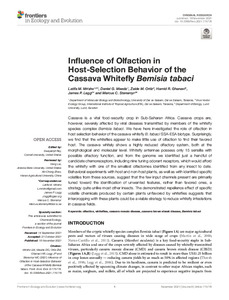| dc.contributor.author | Mrisho, L. |
| dc.contributor.author | Maeda, D.G. |
| dc.contributor.author | Ortiz, Z.M. |
| dc.contributor.author | Ghanavi, H.R. |
| dc.contributor.author | Legg, J. |
| dc.contributor.author | Stensmyr, M. |
| dc.date.accessioned | 2022-02-01T11:15:25Z |
| dc.date.available | 2022-02-01T11:15:25Z |
| dc.date.issued | 2021-11 |
| dc.identifier.citation | Mrisho, L., Maeda, D.G., Ortiz, Z.M., Ghanavi, H.R., Legg, J. & Stensmyr, M. (2021). Influence of olfaction in host-selection behavior of the cassava whitefly Bemisia tabaci. Frontiers in Ecology and Evolution, 9: 775778, 1-13. |
| dc.identifier.issn | 2296-701X |
| dc.identifier.uri | https://hdl.handle.net/20.500.12478/7335 |
| dc.description.abstract | Cassava is a vital food-security crop in Sub-Saharan Africa. Cassava crops are, however, severely affected by viral diseases transmitted by members of the whitefly species complex Bemisia tabaci. We have here investigated the role of olfaction in host selection behavior of the cassava whitefly B. tabaci SSA-ESA biotype. Surprisingly, we find that the whiteflies appear to make little use of olfaction to find their favored host. The cassava whitely shows a highly reduced olfactory system, both at the morphological and molecular level. Whitefly antennae possess only 15 sensilla with possible olfactory function, and from the genome we identified just a handful of candidate chemoreceptors, including nine tuning odorant receptors, which would afford the whitefly with one of the smallest olfactomes identified from any insect to date. Behavioral experiments with host and non-host plants, as well as with identified specific volatiles from these sources, suggest that the few input channels present are primarily tuned toward the identification of unwanted features, rather than favored ones, a strategy quite unlike most other insects. The demonstrated repellence effect of specific volatile chemicals produced by certain plants unflavored by whiteflies suggests that intercropping with these plants could be a viable strategy to reduce whitefly infestations in cassava fields. |
| dc.description.sponsorship | U-Forsk Program of the Swedish Research Council |
| dc.description.sponsorship | International Institute of Tropical Agriculture |
| dc.format.extent | 1-13 |
| dc.language.iso | en |
| dc.subject | Olfaction |
| dc.subject | Whiteflies |
| dc.subject | Cassava |
| dc.subject | African Cassava Mosaic Virus |
| dc.subject | Bemisia Tabaci |
| dc.subject | East Africa |
| dc.title | Influence of olfaction in host-selection behavior of the cassava whitefly Bemisia tabaci |
| dc.type | Journal Article |
| cg.contributor.crp | Roots, Tubers and Bananas |
| cg.contributor.affiliation | University of Dar es Salaam |
| cg.contributor.affiliation | International Institute of Tropical Agriculture |
| cg.contributor.affiliation | Lund University, Sweden |
| cg.coverage.region | Africa |
| cg.coverage.region | East Africa |
| cg.coverage.country | Tanzania |
| cg.coverage.hub | Eastern Africa Hub |
| cg.researchtheme | Plant Production and Health |
| cg.identifier.bibtexciteid | MRISHO:2021 |
| cg.isijournal | ISI Journal |
| cg.authorship.types | CGIAR and developing country institute |
| cg.iitasubject | Agronomy |
| cg.iitasubject | Cassava |
| cg.iitasubject | Disease Control |
| cg.iitasubject | Food Security |
| cg.iitasubject | Plant Breeding |
| cg.iitasubject | Plant Diseases |
| cg.iitasubject | Plant Health |
| cg.iitasubject | Plant Production |
| cg.journal | Frontiers in Ecology and Evolution |
| cg.notes | Open Access Journal; Published online: 18 Nov 2021 |
| cg.accessibilitystatus | Open Access |
| cg.reviewstatus | Peer Review |
| cg.usagerightslicense | Creative Commons Attribution 4.0 (CC BY 0.0) |
| cg.targetaudience | Scientists |
| cg.identifier.doi | https://dx.doi.org/10.3389/fevo.2021.775778 |
| cg.iitaauthor.identifier | James Legg: 0000-0003-4140-3757 |
| cg.futureupdate.required | No |
| cg.identifier.issue | 775778 |
| cg.identifier.volume | 9 |

